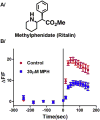Synaptic optical imaging platforms: Examining pharmacological modulation of neurotransmitter release at discrete synapses
- PMID: 25837712
- PMCID: PMC5563461
- DOI: 10.1016/j.neuropharm.2015.03.013
Synaptic optical imaging platforms: Examining pharmacological modulation of neurotransmitter release at discrete synapses
Abstract
Chemical synapses are not only fundamental functional units of the brain but also anatomical and functional biomarkers of numerous brain disorders. Therefore, new experimental readouts of synaptic function are needed--with the spatial resolution of single synapses and the scale to image large ensembles of synapses in specific circuits--for the study of both acute and chronic effects of pharmacological agents on synaptic plasticity in living mammals. In this article we discuss the design and use of fluorescent false neurotransmitters (FFNs) as an important step in the development of versatile synaptic imaging platforms. This article is part of the Special Issue entitled 'Fluorescent Tools in Neuropharmacology'.
Keywords: Brain receptors; Fluorescent probes; In vivo imaging; Synapses; Synaptic transmission.
Copyright © 2015. Published by Elsevier Ltd.
Figures



Similar articles
-
Visualizing neurotransmitter secretion at individual synapses.ACS Chem Neurosci. 2013 May 15;4(5):648-51. doi: 10.1021/cn4000956. ACS Chem Neurosci. 2013. PMID: 23862751 Free PMC article.
-
A theory of synaptic transmission.Elife. 2021 Dec 31;10:e73585. doi: 10.7554/eLife.73585. Elife. 2021. PMID: 34970965 Free PMC article.
-
Astrocytes in endocannabinoid signalling.Philos Trans R Soc Lond B Biol Sci. 2014 Oct 19;369(1654):20130599. doi: 10.1098/rstb.2013.0599. Philos Trans R Soc Lond B Biol Sci. 2014. PMID: 25225093 Free PMC article. Review.
-
Independent functions of hsp90 in neurotransmitter release and in the continuous synaptic cycling of AMPA receptors.J Neurosci. 2004 May 19;24(20):4758-66. doi: 10.1523/JNEUROSCI.0594-04.2004. J Neurosci. 2004. PMID: 15152036 Free PMC article.
-
Stress-Induced Synaptic Dysfunction and Neurotransmitter Release in Alzheimer's Disease: Can Neurotransmitters and Neuromodulators be Potential Therapeutic Targets?J Alzheimers Dis. 2017;57(4):1017-1039. doi: 10.3233/JAD-160623. J Alzheimers Dis. 2017. PMID: 27662312 Review.
Cited by
-
Chemical Targeting of Voltage Sensitive Dyes to Specific Cells and Molecules in the Brain.J Am Chem Soc. 2020 May 20;142(20):9285-9301. doi: 10.1021/jacs.0c00861. Epub 2020 May 12. J Am Chem Soc. 2020. PMID: 32395989 Free PMC article.
-
Analytical Techniques in Neuroscience: Recent Advances in Imaging, Separation, and Electrochemical Methods.Anal Chem. 2017 Jan 3;89(1):314-341. doi: 10.1021/acs.analchem.6b04278. Epub 2016 Nov 22. Anal Chem. 2017. PMID: 28105819 Free PMC article. No abstract available.
-
Identification of Fluorescent Small Molecule Compounds for Synaptic Labeling by Image-Based, High-Content Screening.ACS Chem Neurosci. 2018 Apr 18;9(4):673-683. doi: 10.1021/acschemneuro.7b00263. Epub 2017 Dec 18. ACS Chem Neurosci. 2018. PMID: 29215865 Free PMC article.
References
-
- Aston-Jones G, Cohen JD. An integrative theory of locus coeruleus-norepinephrine function: adaptive gain and optimal performance. Ann Rev Neurosci. 2005;28:403–450. - PubMed
-
- Bamford NS, Zhang H, Schmitz Y, Wu NP, Cepeda C, Levine MS, Schmauss C, Zakharenko SS, Zablow L, Sulzer D. Heterosynaptic dopamine neurotransmission selects sets of corticostriatal terminals. Neuron. 2004;42:653–663. - PubMed
-
- Branco T, Staras K. The probability of neurotransmitter release: variability and feedback control at single synapses. Nat Rev Neurosci. 2009;10:373–383. - PubMed
Publication types
MeSH terms
Substances
Grants and funding
LinkOut - more resources
Full Text Sources
Other Literature Sources

